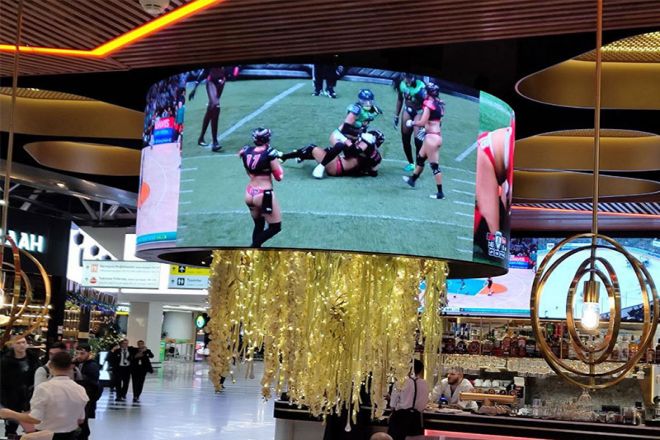Introduction

With the continuous development of science and technology, LED display screens have been widely used in various fields, such as commercial advertising, sports events, traffic instructions, etc.
Its high brightness, high definition, and bright colors make information transmission more intuitive and efficient. However, it is these advantages that can also become a problem in some cases, especially when the glare generated by the LED display screen causes discomfort or interference to the viewer.
Glare not only affects the viewer’s visual experience, causing problems such as eye fatigue and headaches but may also reduce the efficiency of information transmission and even cause safety hazards on some special occasions (such as driving).
Therefore, an in-depth understanding of the glare problem of LED display screens and exploring its causes and solutions are of great significance to improving the use effect of LED display screens and the comfort of viewers.
1. Definition of the glare of LED display screen
LED display screen glare refers to a visual discomfort phenomenon felt by viewers due to the characteristics of the light emitted by the display screen when using the LED display screen. Specifically, LED display screen glare has the following characteristics:
- High brightness:
LED display screens are widely used on various occasions due to their high brightness. However, when the brightness is too high, especially under conditions of dim ambient light, the high brightness of the LED display screen may become the main source of glare. High-brightness light shines directly into the viewer’s eyes, which can easily cause visual fatigue and discomfort.
- High contrast:
LED displays usually have a high contrast, which makes the images and text on the screen clearer. However, a contrast that is too high also increases the possibility of glare. Because the contrast is too high, the brightness difference between the bright and dark areas on the screen is too large. This extreme brightness contrast can irritate the eyes and cause glare.
- Light source distribution:
The light source of the LED display is the LED lamp beads. The distribution and arrangement of these lamp beads on the screen will also affect the generation of glare. If the distribution of LED lamp beads is uneven or the brightness of the lamp beads in certain areas is too high, it may cause glare.
- Viewing angle:
The angle at which the LED display is viewed will also affect the perception of glare. At certain angles, the light from the LED display may directly hit the viewer’s eyes, causing glare. In addition, if the viewer needs to watch the screen at a specific angle for a long time, the risk of glare will also increase.
2. The impact of glare on LED display screens

1). Impact on viewers
- Eye fatigue and discomfort
The high brightness and high contrast characteristics of LED displays will produce glare under certain conditions, directly irritating the viewer’s eyes and causing visual fatigue and discomfort.
If you are in a glare environment for a long time, your eyes will feel dry and painful, and you may even experience symptoms such as tears and blurred vision.
- Reduced viewing comfort and experience
Glare will interfere with the viewer’s perception of the screen content, making it difficult to watch and reducing the overall viewing comfort.
It is difficult for viewers to concentrate and cannot clearly see the content on the screen, which affects the reception and understanding of information.
- Health problems caused by long-term viewing
Long-term eye fatigue and discomfort may lead to eye diseases such as decreased vision and myopia.
Glare may also affect the viewer’s biological clock and sleep quality, leading to health problems such as headaches and insomnia.
2). Impact on the application of LED display screens
- Reduced information transmission efficiency
When glare occurs on the LED display screen, it is difficult for the viewer to clearly see the content on the screen, resulting in obstructed information transmission.
This will not only reduce the speed of information transmission but also may affect the accuracy and completeness of the information.
- Damage to brand image and market acceptance
If the glare problem of the LED display screen is serious, it will bring a bad viewing experience to the audience, which will have a negative impact on the brand image.
In advertising or publicity, glare may make the audience disgusted or ignore the advertising content, reducing the communication effect of the advertisement.
In the long run, the glare problem may also affect the market acceptance of LED display screens and reduce the competitiveness of products.
- Safety hazards
On some special occasions, such as driving, the glare generated by the roadside LED display screen may distract the driver’s attention and increase the risk of traffic accidents.
In occasions that require high concentration (such as factory production lines, operating rooms, etc.), glare may cause operational errors or safety accidents.
3. Causes of glare on LED display screens
The causes of glare on LED display screens can be attributed to the following aspects:
1). Light source factors:
- Brightness:
The excessive brightness of the LED light source is one of the main causes of glare. When the brightness of the LED display screen is too high, especially under conditions of dim ambient light, the high-brightness light directly shines on the viewer’s eyes, which is easy to cause visual fatigue and discomfort.
- Color temperature:
Color temperature is also a factor that affects glare. LED light sources with high color temperature will produce more dazzling light, increasing the possibility of glare.
- Light distribution:
The distribution and arrangement of LED light sources on the display screen will also affect the generation of glare. If the distribution of LED lamp beads is uneven or the brightness of the lamp beads in certain areas is too high, glare may occur.
2). Display screen design:
- Pixel density:
Too high or too low pixel density may affect the glare performance of the display screen. Too high pixel density may cause the pixels to be too dense, making the light more concentrated and thereby increasing the possibility of glare.
Too low pixel density may cause the image to be unclear, requiring the viewer to get closer to the screen to obtain sufficient information, which may also increase the risk of glare.
- Screen size:
The larger the screen size, the larger the luminous area of the light source, which may increase the range of glare.
- Viewing distance:
Too close or too far viewing distance may affect the perception of glare. Too close distance allows light to directly enter the eyes, increasing the possibility of glare; while too far distance may cause light to scatter during propagation, reducing the degree of glare.
3). Environmental factors:
- Ambient light intensity:
The contrast between ambient light intensity and the brightness of the LED display screen will affect the generation of glare. When the ambient light is dark, the high brightness of the LED display screen may be more obvious, increasing the possibility of glare.
- Reflective surface:
The surrounding reflective surfaces (such as glass, metal, etc.) may reflect the light of the LED display screen into the viewer’s eyes, increasing the degree of glare.
- Viewing angle:
Viewing angle is also a factor that affects glare. At certain angles, the light from the LED display may directly hit the viewer’s eyes, causing glare. In addition, if the viewer needs to watch the screen at a specific angle for a long time, the risk of glare will also increase.
4. Solutions for LED display glare

For the problem of LED display glare, the following are a series of effective solutions:
- Improve light source technology:
Use low-brightness, high-uniformity LED light sources to reduce the overall brightness of the screen and reduce eye stimulation.
Optimize the color temperature of the LED light source, choose a softer light, and reduce the impact of glare on the viewer.
Improve the emitting angle and light distribution of the LED light source to ensure uniform light distribution and avoid glare caused by excessive local brightness.
- Optimize the display design:
Adjust the pixel density to match the screen size and viewing distance to avoid glare caused by too dense or sparse pixels.
Consider the proportional relationship between screen size and viewing distance to ensure that viewers can watch the screen content comfortably while reducing the occurrence of glare.
Use an anti-glare coating or film to reduce the reflected light on the screen surface and reduce the degree of glare.
- Environmental control:
Reasonably set the ambient light intensity to ensure that the ambient light matches the brightness of the LED display screen and avoid excessive ambient light causing the screen brightness to be too high.
Reduce the presence of reflective surfaces, such as using low-reflectivity materials to cover the surrounding surfaces to reduce the impact of reflected light on viewers.
Reasonably arrange the viewing position to avoid directly facing strong light sources or reflective surfaces to reduce the occurrence of glare.
- Viewer protection:
Provide anti-glare glasses to help viewers reduce the impact of glare on the eyes and improve viewing comfort.
Adjust the viewing angle to avoid strong light contrast directly with the LED display screen to reduce the perception of glare.
Perform vision examinations regularly to ensure the health of the viewer’s vision and reduce the damage to the eyes caused by long-term viewing.
- Industry standards and policy supervision:
Establish strict glare standards to ensure that LED displays meet relevant standards during the design and production process and reduce glare risks.
Strengthen market supervision, punish and rectify LED displays that do not meet the standards, and protect consumer rights.
Encourage enterprises to invest in research and development, promote the continuous advancement of LED display technology, and improve product performance and quality.
Conclusion
With the continuous advancement of science and technology, we have reason to believe that future LED displays will make greater breakthroughs in reducing glare. By improving light source technology, optimizing display design, and strengthening environmental control, we can effectively reduce glare and improve the use of LED displays and the comfort of viewers.
At the same time, the strengthening of industry standards and policy supervision will also provide strong guarantees for the healthy development of LED displays.
If you want to know more about LED displays, please get in touch with us.
